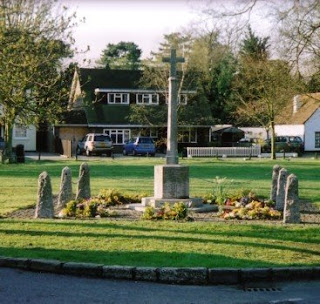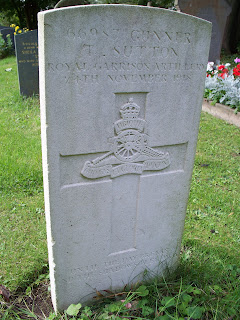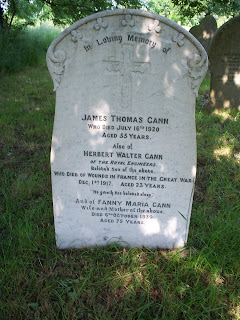
On The Green at Blackmore is the village War Memorial commemorating those who died and those who served in the First World War. There is no permanent memorial to those who gave their lives in World War Two. It is a hexagonal pillar. On the front face are the names of 21 men who gave their lives. To the left is a list of those men from Blackmore who served whilst to the right are those men associated with Blackmore who served.
The Memorial was unveiled in 1920 so pre-dates the deaths of Frank James Monk (1921) and Jacob Wiltshire (1923) who also died from their wounds. Both of these men are buried in the churchyard at Blackmore and have a non war commission headstone. Alfred Ellis appears on the memorial window inside the Priory Church of St Laurence, Blackmore, but not on the War Memorial.
The War Memorial was dedicated on 7th November 1920, four days before the second Anniversary of the Armistice when people would have gathered and paused for two minutes to remember. The Essex County Chronicle reported: “The unveiling of the war memorial took place on Sunday afternoon, a very large number of people being present. The ceremony began with the singing of “O God Our Help In Ages Past” followed by the lesson read by the Vicar (the Revd. W L Petrie) and prayers by Pastor Francis. At the request of Mr Edmund Marriage, Lieut. Col. Gibbons D.S.O. then unveiled the memorial congratulating Blackmore for having sent 103 men out of a population of 600. He mentioned that one in every five had paid the supreme sacrifice – Mr J H Hull then asked Mr E Marriage as Chairman of the Parish Council, to accept custody of the memorial. The names of the fallen are inscribed on the front face, and on the other faces the names of the men from the village who served are inscribed”[1].
The names recorded on the War Memorial are as follows:
In memory of those who gave
their lives for their country
in the Great War 1914 – 1918
Sec Lieut G W Pigott RFA
Sec Lieut A I Miller MMRIR
Stoker W Brazier RN
A/B E Alexander RN
A/B W Wash RN
A/Mech W Scudder RNAS
Pte G White RMLI
Bomd. A Godding RFA
Gr E Sutton RCA
Drv C Wash RE
Drv A J Wheal RE
Pte D Sutton R Fus
Pte H Riglin Suffolk
Pte W Rudling Suffolk
Pte H Game E Surrey
Pte H Miller E Surrey
L Corp E Maynard Essex
Pte A Barker Essex
Pte E Martin Essex
Pte A Nash Essex
Pte J Roast Essex
At the foot of the memorial is the inscription:
‘Their name liveth for evermore’
The following connected
with Blackmore also
served in His Majesty’s
Forces
Pte A Roast Bedford
Pte H Allen Border
Corp C Miller Essex
Corp J Monk Essex
Corp P Pagram Essex
Pte W Chumbley Essex
Pte C Hasler Essex
Pte T Livings Essex
Pte C Miller Essex
Pte H Ovel Essex
Pte F Penson Essex
Pte C Stiff Essex
Pte H White Essex
Pte J Wiltshire Essex
Pte F Wilson Essex
Pte G Woollard Essex
Pte J Wray Essex
Pte A Wright Essex
Pte A Chumbley Middsx
Pte R Chapman Middsx
Sgt W Sankey RASC
Cpl J Pagram RASC
Drv P Roast RASC
Pte W Burr RASC
Pte W Chumbley RASC
Pte A McLaren RASC
Pte E Ovel RASC
Pte C Pagram RASC
Pte F Wood RASC
Pte A Boyd RAMC
Sgt/Mec C Pratt RAF
Sgt H Matthews RAF
Ft Sgt J Woollard DSM
Cpl/Mec G Newcombe RAF
A/M A Ovel RAF
L/Cpl A Wheal MCC
Gr C Knight MCC
Pte L Chumbley MCC
Pte H Pavitt ACC
Gr T Roast Tank C
Pte C Wray Labour C
Pte F Smith Labour C
The following connected
with Blackmore also
served in His Majesty’s Forces
Lieut-Col W G Piggott .
OBE Rifle Bde
Major H C C Hackney .
RAMC (TF)
Capt J H Hull Essex
Sub-Lt A L Jasper PMR
Sec-Lt G V Jasper MGC
Sec-Lt R Ingram RAF
P Offr A Griffiths RN
P Offr D Martin RN
Cr G Attridge RN
A/B S Ball RN
A/B S Brazier RN
Str E Brown RN
A/B G Farmer RN
A/B E Murkin RN
Str J Murkin RN
Str F Saye RN
Str A Wheal RN
A/B W Woollard RN
OS J Wilson RN
A/M L Ingram RMES
Tr B Whitmore Essex Yeo
Tr R Whitmore 15th Hus
Gr W Wood RFA
Gr J Brinkley RGA
Gr A Jobson RGA
Gr J Monk RGA
Spr B Surridge RE
Spr T West RE
Pte E Puddephatt RW Surrey
Pte F Wray RW Surrey
Pte W Brown Roy Fus
Pte H Rayner Roy Fus
Pte E Wager Roy Fus
Pte G Wash Roy Fus
Pte H Game X Liverpool
Pte A Hart Norfolk
Pte A Humphreys Norfolk
Pte J Horrex Devon
Pte S Martin Suffolk
[1] ERO. T/P 181/2/11. A quotation taken from a newspaper cutting in the Cuttle collection, dated 12th November 1920, concerning the dedication of the War Memorial.
The Memorial was unveiled in 1920 so pre-dates the deaths of Frank James Monk (1921) and Jacob Wiltshire (1923) who also died from their wounds. Both of these men are buried in the churchyard at Blackmore and have a non war commission headstone. Alfred Ellis appears on the memorial window inside the Priory Church of St Laurence, Blackmore, but not on the War Memorial.
The War Memorial was dedicated on 7th November 1920, four days before the second Anniversary of the Armistice when people would have gathered and paused for two minutes to remember. The Essex County Chronicle reported: “The unveiling of the war memorial took place on Sunday afternoon, a very large number of people being present. The ceremony began with the singing of “O God Our Help In Ages Past” followed by the lesson read by the Vicar (the Revd. W L Petrie) and prayers by Pastor Francis. At the request of Mr Edmund Marriage, Lieut. Col. Gibbons D.S.O. then unveiled the memorial congratulating Blackmore for having sent 103 men out of a population of 600. He mentioned that one in every five had paid the supreme sacrifice – Mr J H Hull then asked Mr E Marriage as Chairman of the Parish Council, to accept custody of the memorial. The names of the fallen are inscribed on the front face, and on the other faces the names of the men from the village who served are inscribed”[1].
The names recorded on the War Memorial are as follows:
In memory of those who gave
their lives for their country
in the Great War 1914 – 1918
Sec Lieut G W Pigott RFA
Sec Lieut A I Miller MMRIR
Stoker W Brazier RN
A/B E Alexander RN
A/B W Wash RN
A/Mech W Scudder RNAS
Pte G White RMLI
Bomd. A Godding RFA
Gr E Sutton RCA
Drv C Wash RE
Drv A J Wheal RE
Pte D Sutton R Fus
Pte H Riglin Suffolk
Pte W Rudling Suffolk
Pte H Game E Surrey
Pte H Miller E Surrey
L Corp E Maynard Essex
Pte A Barker Essex
Pte E Martin Essex
Pte A Nash Essex
Pte J Roast Essex
At the foot of the memorial is the inscription:
‘Their name liveth for evermore’
The following connected
with Blackmore also
served in His Majesty’s
Forces
Pte A Roast Bedford
Pte H Allen Border
Corp C Miller Essex
Corp J Monk Essex
Corp P Pagram Essex
Pte W Chumbley Essex
Pte C Hasler Essex
Pte T Livings Essex
Pte C Miller Essex
Pte H Ovel Essex
Pte F Penson Essex
Pte C Stiff Essex
Pte H White Essex
Pte J Wiltshire Essex
Pte F Wilson Essex
Pte G Woollard Essex
Pte J Wray Essex
Pte A Wright Essex
Pte A Chumbley Middsx
Pte R Chapman Middsx
Sgt W Sankey RASC
Cpl J Pagram RASC
Drv P Roast RASC
Pte W Burr RASC
Pte W Chumbley RASC
Pte A McLaren RASC
Pte E Ovel RASC
Pte C Pagram RASC
Pte F Wood RASC
Pte A Boyd RAMC
Sgt/Mec C Pratt RAF
Sgt H Matthews RAF
Ft Sgt J Woollard DSM
Cpl/Mec G Newcombe RAF
A/M A Ovel RAF
L/Cpl A Wheal MCC
Gr C Knight MCC
Pte L Chumbley MCC
Pte H Pavitt ACC
Gr T Roast Tank C
Pte C Wray Labour C
Pte F Smith Labour C
The following connected
with Blackmore also
served in His Majesty’s Forces
Lieut-Col W G Piggott .
OBE Rifle Bde
Major H C C Hackney .
RAMC (TF)
Capt J H Hull Essex
Sub-Lt A L Jasper PMR
Sec-Lt G V Jasper MGC
Sec-Lt R Ingram RAF
P Offr A Griffiths RN
P Offr D Martin RN
Cr G Attridge RN
A/B S Ball RN
A/B S Brazier RN
Str E Brown RN
A/B G Farmer RN
A/B E Murkin RN
Str J Murkin RN
Str F Saye RN
Str A Wheal RN
A/B W Woollard RN
OS J Wilson RN
A/M L Ingram RMES
Tr B Whitmore Essex Yeo
Tr R Whitmore 15th Hus
Gr W Wood RFA
Gr J Brinkley RGA
Gr A Jobson RGA
Gr J Monk RGA
Spr B Surridge RE
Spr T West RE
Pte E Puddephatt RW Surrey
Pte F Wray RW Surrey
Pte W Brown Roy Fus
Pte H Rayner Roy Fus
Pte E Wager Roy Fus
Pte G Wash Roy Fus
Pte H Game X Liverpool
Pte A Hart Norfolk
Pte A Humphreys Norfolk
Pte J Horrex Devon
Pte S Martin Suffolk
[1] ERO. T/P 181/2/11. A quotation taken from a newspaper cutting in the Cuttle collection, dated 12th November 1920, concerning the dedication of the War Memorial.








